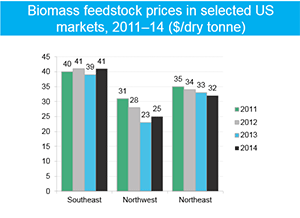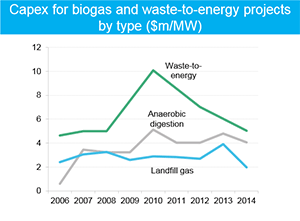While sustainable energy will continue to grow, report finds challenges for biomass, waste-to-energy and anaerobic digestion businesses.
 |
Analysts with Bloomberg New Energy Finance have released their third annual Sustainable Energy in America Factbook, which shows that investments in clean energy in the United States continues to grow at a strong clip. The report was prepared for the Business Council for Sustainable Energy (BCSE www.bcse.org).
According to the Factbook, from 2007-2014, total U.S. investments in clean energy, including renewables and advanced grid, storage and electrified transport technologies, reached $386 billion.
While the growth in sustainable and renewable energy sources that could replace coal and oil are promising, biomass, waste-to-energy and anaerobic digestion operations are a number of sectors that may struggle with limited access to financing.
“The 2015 Factbook clearly shows that America is on the path to a more sustainable energy sector,” says Lisa Jacobson, president of the BCSE. “Our energy productivity is rising along with economic growth, while energy-intensive industries are onshoring production to the United States to take advantage of low energy costs. All of this is happening as investment in clean energy continues to grow and as new natural gas infrastructure continues to come online. These are strong positive signs for America’s economy and environment.”
 |
| IInvestment costs for waste-to-energy, anaerobic digestion and landfill gas projects decreased slightly in 2014. |
Key trends highlighted in the Factbook include the following:
- The U.S. economy is becoming more energy productive, with “an outright decoupling between electricity growth and economic growth.” Between 1990 and 2007, electricity demand grew at an annual rate of 1.9 percent while, between 2007 and 2014, annualized electricity demand growth has been zero. Meanwhile, over those past seven years the U.S. economy has grown by 8 percent.
- The U.S. power sector is decarbonizing, with the contribution of renewable energy to U.S. electricity rising from 8.3 percent in 2007 to about 12.9 percent in 2014. Meanwhile, production and consumption of natural gas is reached record highs in 2014. Since 2000, Bloomberg’s Factbook shows that 93 percent of new power capacity built in the United States has come from natural gas and renewable energy.
- Investment in U.S. clean energy is increasing. The U.S. clean energy sector has seen $35-65 billion of investment each year since 2007, a significant increase over the annual investment of $10.3 billion in 2004. Overall, U.S. investment in clean energy totaled $51.8 billion in 2014, a 7 percent increase from 2013 levels. The United States finished the year ranked second globally for new dollars invested in clean energy.
“Against the backdrop of a surging economy and crumbling oil prices, major trends around decarbonization and improving energy productivity continued in the United States,” says Michel Di Capua, head of Americas’ research for Bloomberg New Energy Finance. “Low-carbon energy technologies stand to benefit from key policies proposed in 2014, including the U.S. Environmental Protection Agency’s proposed regulation for the power sector and an innovative new vision for the electricity market in New York State.”
While the United States is clearly heading toward more use of sustainable energy, the Factbook did show deviations from the larger trend. These include an increase of coal’s share in U.S. electricity generation from 37 percent in 2012 to an estimated 39 percent in 2013 and 2014; an increase in carbon emissions from the U.S. energy sector of around 3 percent since 2012; and a slowdown in utilities’ and states’ adoption of energy efficiency.
The Factbook adds that policy will play a central role in determining where the U.S. energy mix heads in 2015 and beyond. State, federal and international policies – including the EPA’s Clean Power Plan regulation on existing power plants; the global climate negotiations scheduled in Paris this fall; and federal and state-level support for renewables, efficiency and natural gas development – will all help determine the speed with which the trend toward sustainable energy develops in 2015.
The Factbook also contains extensive analysis, charts and data on sustainable energy trends in 2014, including energy storage, oil and transportation, distributed energy, combined heat and power (CHP), carbon capture and storage (CCS) and natural gas infrastructure investment.
While overall renewable energy usage and investments are growing, Bloomberg’s Factbook is less bullish on a host of the renewable energy sources, notably biomass, biogas, anaerobic digestion and waste-to-energy.
The report notes that while policy support measures, including the Production and Investment Tax Credits, led to a sharp increase in biomass installations in 2013 at 521 megawatts, the following year biomass installations dropped to 30 MW. Extending further, the Factbook notes that incentives are closed to new entrants, which means it is likely there will be less new biomass capacity over the next few years.
More problematic, in 2014 there was more biomass capacity retired (89 megawatts) than installed (30 megawatts), which reduced total biomass capacity to 8.4 gigawatts.
For biogas, Bloomberg’s Factbook notes that capacity has been declining since 2010; and there were no new waste-to-energy installations in 2014.
Financing for new biomass, biogas and waste-to-energy operations also declined in 2013 and 2014. (Less than $50 million for biomass, slightly more than $100 million for biogas and no financing for waste-to-energy operations). For biomass, the decline in investment was due to the expiration of the Production Tax Credit. For waste-to-energy and biogas projects, because they are in generally smaller sectors there were fewer deal available.
Extending out, the low levels of investment in the bioenergy sector in 2013 and 2014 means there will likely be fewer new facilities over the next few years because it takes 2-4 years to complete the construction and commissioning of these projects.
For anaerobic digesters, the report notes that new activity in small-scale anaerobic digestion operations is starting to slow. The report finds that between 2008 and 2013 the number of small anaerobic digester projects at agricultural facilities grew steadily, with between 20 and 36 new operational projects opening, while 29 projects closed shop down over the five-year period.
However, over the past two years the development of small anaerobic digester projects has tailed off.
There are currently 243 operational anaerobic digester projects at farms in the United States. These facilities are generally small – with an average size of 707kW. Of the total, 169 of these were smaller than 1MW, representing 59MW in capacity.
The full 2015 edition of the Sustainable Energy in America Factbook is available at www.bcse.org/sustainableenergyfactbook.html.